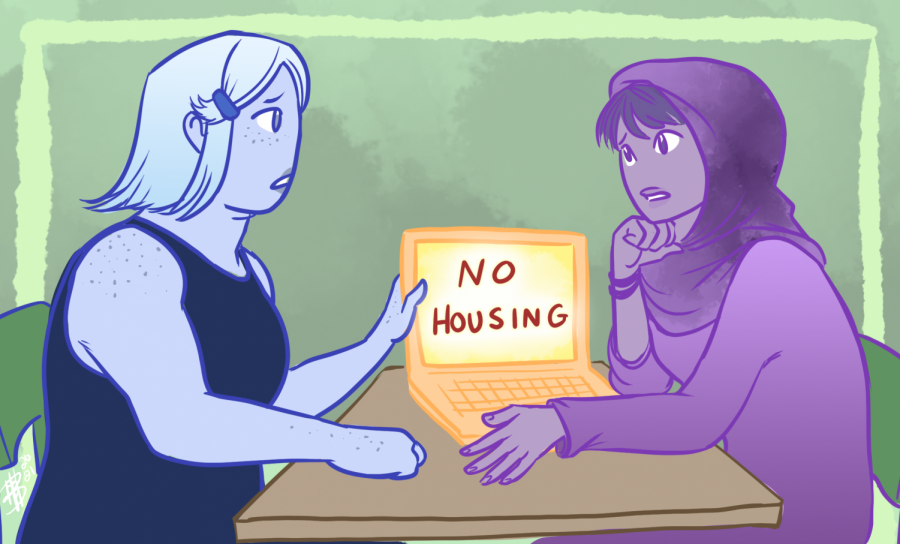Malick: Expensive housing may restrict OSU accessibility
This illustration shows two students conversing about the availability of housing. For OSU students, finding affordable housing can be a struggle, with a rising demand and a slow growth in supply.
September 27, 2021
Editor’s Note: This column does not represent the opinion of The Daily Barometer. This column reflects the personal opinions of the writer.
With the fall term beginning soon, many students returning to Corvallis, Ore. are looking for housing, a task easier said than done.
Corvallis has been hailed by Forbes and Livability as one of the top ten college towns in the United States. But housing here is expensive and difficult to find, and demand will keep growing as enrollment continues to rise.
Searching Zillow, an online real-estate marketplace, you can expect to see that prices for two-bedroom apartments are fairly consistently over a thousand dollars a month. The average rent for an apartment in Corvallis is $1,389 a month, which costs $1.59 per square foot. Neighboring Eugene, which has a $1.70 average, has more than twice the population and is only about 7% more expensive.
According to Paul Bilotta, the community development director for the City of Corvallis, the city is currently experiencing a jobs-housing imbalance. This is a situation where there are more people working in an area than living in it.
“It took a few decades for Corvallis to get into its imbalance and it will take some time to correct that imbalance, although progress is being made when you look at increased building permit activity,” Bilotta said.
The City of Corvallis website has a page where the Annual Housing Summary provides public information on housing data.
A zoning map of Corvallis is also available on this website. These tools allow us to under- stand the geography and potential options for the city.
“Although there isn’t a magic ratio to declare when balance is achieved, there are qualitative and quantitative measures that are good indicators,” Bilotta said.
He explained that major employers in Corvallis say they have employees who want to work in Corvallis, but cannot afford housing prices.
Thus, the quantitative measure shows that the number of people living and working in Corvallis has seen almost no increase, and the number of commuters from other places continues to rise.
“I do think it can be difficult for students to find housing in Corvallis,” Michael Carris, an Oregon State University student, said.
“Many students are new to the process and it takes some trial to figure out red flags in bad places and what to look for in good ones, especially when it comes to landlords and such. It can also be a bit difficult because of the way a college town works, in that the rental scene is seasonal.”
The relationship between the students of OSU and the housing market in Corvallis means that there is rising demand and slow growth in supply.
As prices go up, it makes OSU inaccessible for low-income students. If our community is going to be one of true diversity and inclusivity, this problem must be solved.
The OSU website states that 23,266 students live in Corvallis. As this number continues to grow, Corvallis will need to grow, too. To help with this, Billota says the City Council approved the Marys Annexation on Sept. 7, which is about 118 acres in size. This site is along West Hills and 53rd.
According to Bilotta, changes have also been made to the Corvallis Land Development Code to make it easier for housing projects to be approved. These changes are promising, though time will have to tell if they are enough.
“Through my own experience, I found it’s super stressful to balance finals and have your lease run out,” Carris said. “Taking time out of studying to search for places and compete with other students can be a lot to deal with.”











































































































